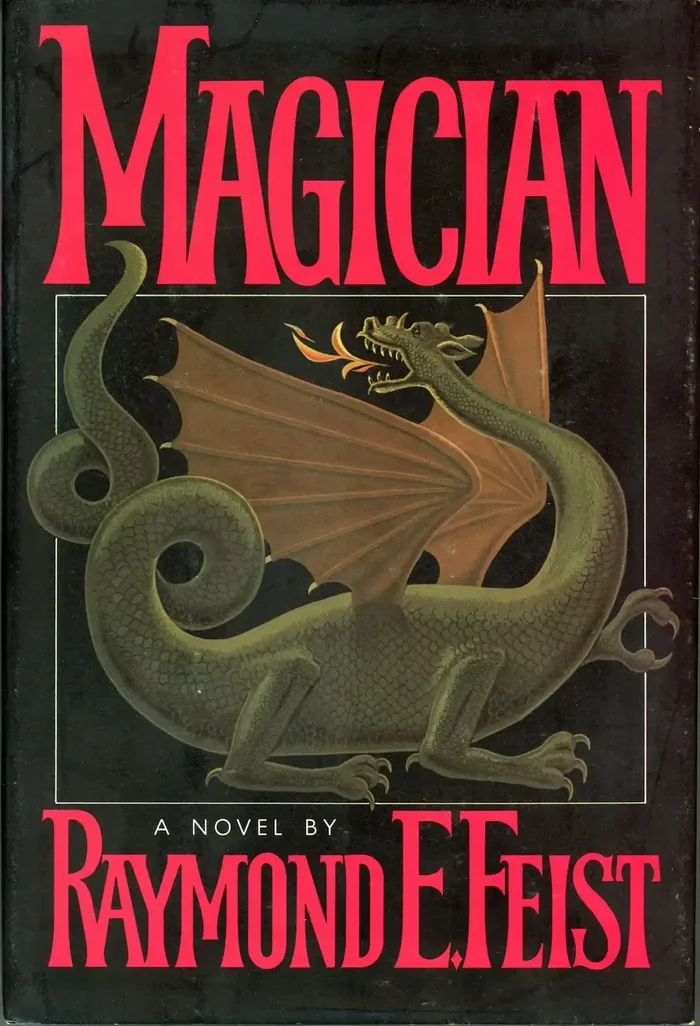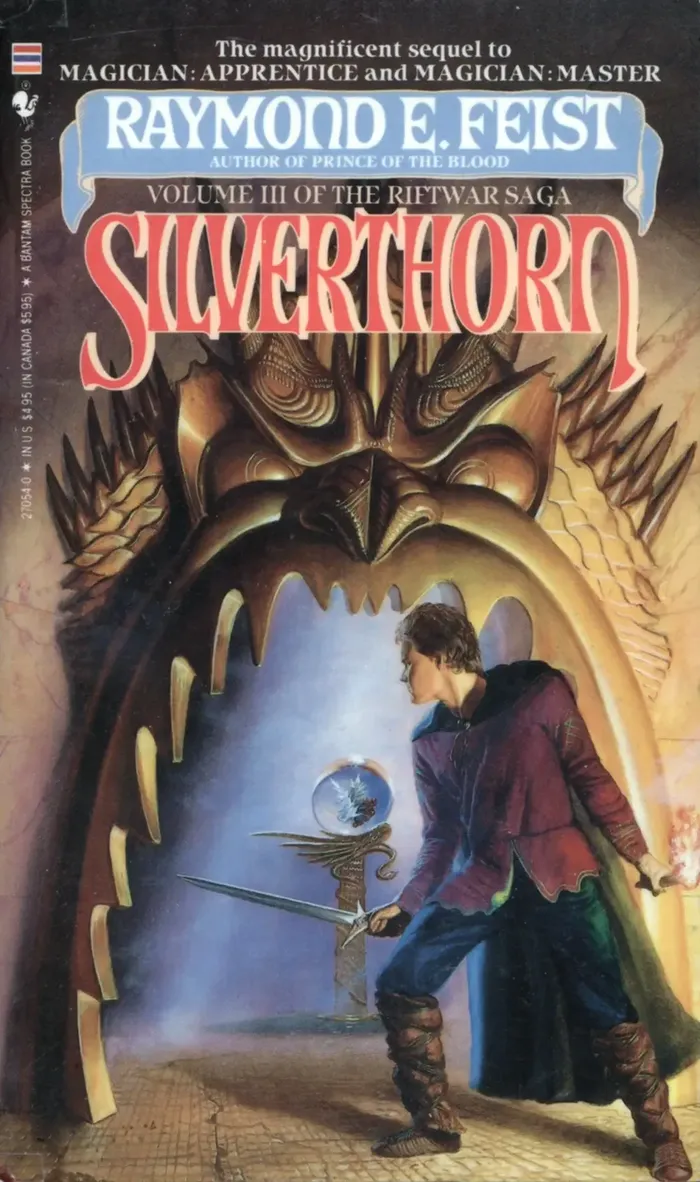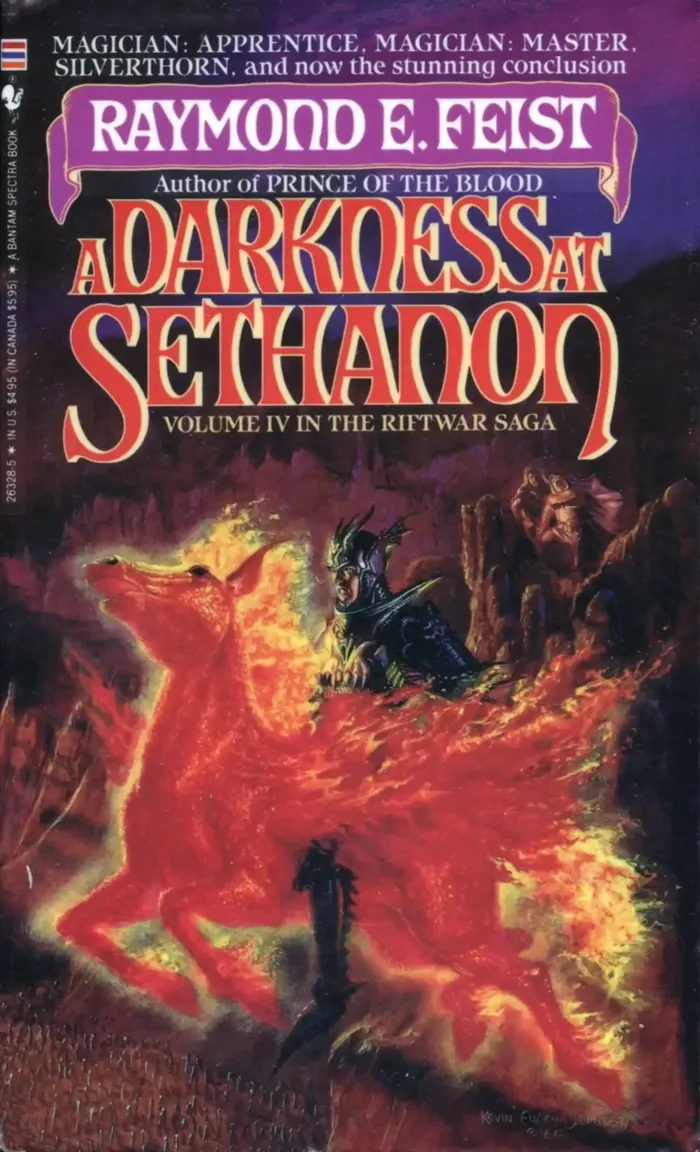Convalescing in Krondor
I was sick for the better part of last week, the sort of lingering illness that robs you of all energy, motivation, and interest. Which means that despite having a pile of books, movies, etc., that I could’ve been using to potentially alleviate my suffering, I had virtually no interest in any of them. And those that were tried often had some unforeseen side effects. (I made the mistake of watching some Shōgun when I was at my sickest and subsequently had some incredibly vivid and disconcerting samurai-themed fever dreams.)

I therefore found myself reaching for some of the oldest items on my bookshelf: a trilogy of novels that comprise Raymond E. Feist’s Riftwar Saga. Published in the early-to-mid ’80s, and acquired by myself in the mid ’90s, Magician, Silverthorn, and A Darkness at Sethanon are about as trope-filled as fantasy novels get. They contain several “chosen one” storylines; dwarves, dragons, and various types of elves that feel lifted right out of central Tolkien casting; powerful wizards and magical items; and ancient prophecies concerning vast, unknowable evils that threaten all of creation.
In Magician (1982), a mysterious foe invades the outermost regions of the Kingdom of the Isles. As the Kingdom mounts its defense, a lowly orphan named Pug begins to discover his magical potential — a potential that’s ultimately realized on an alien world. Meanwhile, the Kingdom must confront a mad king and a threat to both worlds. In Silverthorn (1985), the Kingdom is recovering from the war. But when an assassin attacks a royal wedding, it portends a greater danger lurking in the shadows. As Arutha, Prince of Krondor, races to save his bride, Pug must return to the world where he gained his magical mastery to uncover the truth of this danger. And finally, A Darkness at Sethanon (1986) brings things to a head, as Pug searches for a powerful wizard thought to be dead and Arutha must rally whatever forces he can find against the monstrous armies of the vile Murmandamus.
Not surprisingly, the trilogy emerged from a role-playing game called Midkemia, a D&D-like system that Feist and his friends developed in the early ’80s. (Midkemia is also the name of the world in which most of Feist’s stories occur.) But the novels also weave in elements from M. A. R. Barker’s Tékumel fantasy setting, most notably with the Tsurani, an empire from another world called Kelewan that’s primarily influenced by feudal Japan with aspects of Aztec culture sprinkled here and there. When the Tsurani invade Midkemia through extra-dimensional portals, it leads to an inevitable culture clash that could spell doom for both worlds, and beyond.

This is the sort of high fantasy storytelling that feels rather old-fashioned nowadays. It has none of Tolkien’s mythopoeia to give it a timeless or elegiac quality. That, and Feist’s shameless culture-mashing (e.g., the Tsurani) would no doubt be flagged as problematic by modern readers. And yet, these novels are the very definition of literary “comfort food” for me, the sort of stuff that I can still enjoy even in the midst of a high fever as I re-read favorite passages for the umpteenth time.
To his credit, Feist knows how to write epic power fantasy. That is, fantasy where the world faces an alien threat of nigh-unlimited power, and yet the our heroes are no pushovers. In Magician, young Pug becomes a master of magic with few rivals while his best friend Tomas becomes the unlikely inheritor of the Dragon Lords, a powerful race that once ruled the cosmos in the distant past. (Yes, they’re actually called the Dragon Lords.) Later, in A Darkness at Sethanon, Pug and Tomas traverse space and time, visit alien cultures — astride a dragon, natch — and even glimpse the Big Bang itself, in their search for allies against said alien threat. (In moments like these, Feist’s novels veer into sci-fi territory, which I honestly don’t mind.)
His novels are filled with epic battles packed with demonic monstrosities and exploding cities as well as swashbuckling and brutally graphic duels that I still find exciting because my inner adolescent still finds them exciting. For me, reading Feist’s novels feels like the epitome of C. S. Lewis’ declaration (emphasis mine): “When I was ten, I read fairy tales in secret and would have been ashamed if I had been found doing so. Now that I am fifty I read them openly. When I became a man I put away childish things, including the fear of childishness and the desire to be very grown up.”
But because Feist’s vision is so grandiose, all of his characters have what I’d consider epic moments even when they’re not battling foes from another universe or wielding incredible magical powers. Even as dragons, wizards, demons, and long-dead alien races wage arcane battles for the fate of creation, Feist weaves in plenty of “mundane” political intrigue and smaller, surprisingly affecting moments for his non-magical characters.
Aside from Pug, the trilogy’s main protagonist is arguably Arutha, a taciturn young prince who might be the subject of an ancient prophecy, but he’s actually far more concerned with ensuring that his kingdom doesn’t fall into political disarray, especially in the aftermath of the Tsurani invasion. But he’s forced to reconsider everything he knows when Fate pairs him with his family’s most hated foe. Meanwhile, his close friend Martin bears an awful secret that could undo everything Arutha is trying to save and a young, ambitious thief named Jimmy the Hand becomes the prince’s unlikeliest confidant.

Even as I acknowledge the trilogy’s rather old-fashioned and un-original nature, I won’t deny that I find it deeply comfortable to read, the bookish equivalent of a favorite blanket or chair. As such, it’s the perfect material for when I’m sick and unable to muster the energy for anything else.
Sick or not, I simply enjoy reading and re-reading Pug and Tomas’ joint rise to godlike power; Pug’s growing understanding of Tsurani culture; Arutha’s first encounters with his future wife and later, his desperate race to save her; the massive battles against the infernal Murmandamus; the secret histories of both the Dragon Lords and the great wizard Macros the Black; and the bizarre phenomena that Pug and Tomas encounter during their journey through space and time — to name but a few things.
Feist would ultimately expand on the Riftwar Saga, writing multiple series to create the Riftwar Cycle, which officially came to an end with the Chaoswar Saga in the early 2010s. The Cycle found Feist dramatically expanding his fictional world with multiple layers of reality, more bizarre alien races, and some increasingly abstract philosophical underpinnings.
I’ve only read about a third of the Cycle’s titles, including Krondor’s Sons and the Chaoswar Saga. For all of Feist’s obvious ambition in narrative and world building, though, the latter novels do feel like the same basic ideas recycled over and over again. (When I started reading the Chaoswar novels without having read much of the preceding material, I was rather surprised at how not lost I felt, even with all of the new characters, settings, and such.) Thus, I prefer to stick with the original saga.
Beyond the Riftwar Cycle, Feist’s most recent series was the Firemane Saga, which concluded with 2022’s Master of Furies and was ostensibly a clean break from the world of Midkemia. (I say “ostensibly” because Feist’s next novel, A Darkness Returns, actually combines his two fictional worlds, which are threatened by — you guessed it! — yet another vast, unknowable evil.) I only read the first Firemane book, 2018’s King of Ashes, because I was curious to see how Feist would do with a seemingly brand new world.
King of Ashes was OK, but like the Riftwar Cycle, Feist’s new work left me feeling little desire to move beyond the adventures of Pug, Tomas, Arutha, Martin, Jimmy the Hand, et al. The original Riftwar Saga has made for perfectly nice, comfortable reading for 30 years now, which is no mean feat, and it’ll no doubt continue to do so in the years to come. I don’t need much more than that.